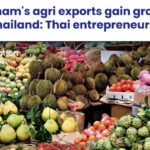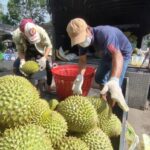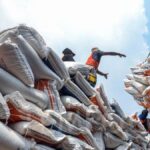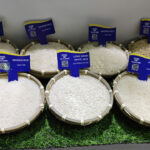According to the Ministry of Agriculture and Environment, in the first four months of 2025, the export turnover of agricultural, forestry, and aquatic products reached 21.15 billion USD, a 10.7% increase compared to the same period last year. This includes 11.6 billion USD from agricultural products, up by 11.7%; 5.56 billion USD from forestry products, up by 11.2%; 3.09 billion USD from aquatic products, up by 13.7%; 178 million USD from livestock products, up by 16.8%; and 722 million USD from production inputs, up by 20%.
MOST KEY EXPORT COMMODITIES ACHIEVE HIGH GROWTH
In the first four months of 2025, six commodities achieved export turnover of over 1 billion USD, with two exceeding 3 billion USD. Notably, most of the key commodities recorded higher export values than the same period last year. For instance, wood and wooden products reached 5.2 billion USD, up by 5.8%; coffee earned 3.78 billion USD, up by 51.1%; rubber brought in 862 million USD, up by 18.9%; and shrimp contributed 1.24 billion USD, up by 28.4%. Conversely, rice and vegetables experienced decreases, with rice at 1.75 billion USD, down by 14.3%, and vegetables at 1.62 billion USD, down by 14.2%.

Regarding average export prices in the first four months of 2025 compared to the same period last year, the Ministry of Agriculture and Environment reported that several agricultural products witnessed double-digit increases, including coffee at 5,698 USD/ton, up by 67.5%; rubber at 1,935 USD/ton, up by 30.2%; peppercorn at 6,893 USD/ton, up by 62.5%; and cashew nuts at 6,808 USD/ton, up by 27%. On the other hand, rice and tea experienced declines, with rice at 514 USD/ton, down by 20%, and tea at 1,608 USD/ton, down by 2.2%.
In terms of export markets during the first four months of 2025 compared to the same period last year, the American market reached 4.83 billion USD, up by 12.6%; the European market attained 3.48 billion USD, up by 37.7%; the African market achieved 648 million USD, up by 78.4%; the Asian market earned 8.82 billion USD, down by 1.3%; and the Oceanian market brought in 263 million USD, down by 2.6%.
The United States, China, and Japan remained the top three consumers of Vietnam’s agricultural, forestry, and aquatic products. Exports to the United States increased by 10.2%, accounting for 20.5% of the total export value of these products; exports to China decreased by 1.1%, accounting for 17.1%; and exports to Japan rose by 23.3%, accounting for 7.5%. However, in April 2025 compared to April 2024, exports of agricultural, forestry, and aquatic products to the United States decreased by 1.4%; to China by 9.7%; and to Japan increased by 26.4%.
According to the Ministry of Agriculture and Environment, while the overall results for the first four months of 2025 indicate growth, if we look at April 2025 alone, exports of forestry and aquatic products declined. This is because these two sectors have a significant proportion of exports going to the United States, and the country is currently imposing a 10% tariff on Vietnamese goods, making exports unstable. In the case of forestry products, the United States usually accounts for 50-55% of Vietnam’s total wood and wooden product exports. In April 2025, exports of these products to the United States decreased by 6.6% compared to April 2024.
IMPACT OF US TAX POLICY BECOMING APPARENT
Regarding aquatic products, the Vietnam Association of Seafood Exporters and Producers (VASEP) reported that exports in the first four months of 2025 witnessed a strong recovery, reaching 3.3 billion USD, up by 21% compared to the same period in 2024. In April 2025 alone, export turnover reached 850.5 million USD, up by 10%. However, against the backdrop of tax instability from the United States, the export picture is uneven across products and markets.
Shrimp continued to be the main export commodity, contributing 1.27 billion USD in the first four months, up by 30% compared to the same period. In April, shrimp exports reached 330.8 million USD, up by 15%. This growth stems from robust demand in major markets such as China, the EU, and Japan, along with shrimp prices gradually recovering due to global supply and demand rebalancing. Tra fish, with a turnover of 632.7 million USD (up by 9%), maintained its important position but experienced slower growth, particularly in April, with a turnover of 167.7 million USD, unchanged from the previous year.
Tuna recorded a decline in April (76.1 million USD, down by 12%) despite a slight increase in the four-month cumulative turnover (304.2 million USD, up by 1%). Other products like tilapia and pink perch witnessed breakthrough growth (138%, reaching 19 million USD). Mollusks (cephalopods, bivalves, and gastropods) and crabs also saw impressive growth, reaching 216.4 million USD (up by 18%), 83.1 million USD (up by 82%), and 112.1 million USD (up by 50%), respectively, thanks to high demand from China and ASEAN.
In terms of markets, China and Hong Kong continued to be the largest consumers, with a turnover of 709.8 million USD in the first four months of 2025, up by 56%; and 182.3 million USD in April 2025, up by 29%. Japan was the second-largest market, with a turnover of 536.6 million USD, up by 22%. The EU and South Korea also showed potential, with turnovers of 351.5 million USD (up by 17%) and 264.1 million USD (up by 15%), respectively. ASEAN became a bright spot, with a turnover of 218.8 million USD, up by 25%. As for the US market, exports in the first four months of 2025 reached 498.4 million USD, up by 7% compared to the same period last year, but in April 2025 alone, they decreased by 15% compared to April 2024, reaching only 120.5 million USD. This decline reflects the impact of the current US tax policy, which disrupts export activities.
Commenting on the US tax policy, Ms. Le Hang, Vice Secretary General of VASEP, stated that these tax policies are putting significant pressure on Vietnam’s seafood exports. Products like tra fish and shrimp, which heavily depend on the US market, are severely affected.
SHIFT TO OTHER MARKETS WILL BE STRENGTHENED
According to Ms. Hang, the Comprehensive and Progressive Agreement for Trans-Pacific Partnership (CPTPP) and other Free Trade Agreements (FTAs) are helping Vietnam mitigate negative impacts by diversifying markets to the EU, Japan, and ASEAN. Vietnamese enterprises are also adjusting their strategies, focusing on value-added products and market diversification to reduce reliance on the US market.
Predicting the trend in the coming months, Ms. Le Hang said that in May and June 2025, Vietnam’s seafood exports would grow strongly before the US’s new tax policy takes effect on July 9, 2025. Accordingly, Vietnamese enterprises will focus on boosting exports to the US, especially for key products like shrimp and tra fish, to maximize benefits before the new tariffs increase costs. It is expected that export turnover to this market may increase by 10-15% compared to April 2025, thanks to urgent contract signings and price reduction strategies to maintain market share.
It is forecast that in the coming months, seafood exports to other markets such as China and ASEAN may slow down, with growth of only about 3-5%. This is due to increasing competition from Chinese seafood products, which face high tariffs in the US and are forced to shift to the domestic market and neighboring markets such as ASEAN. This competition will reduce the attractiveness of Vietnamese products, especially in the low-price segment. The EU and Japan may maintain stable growth (around 8-10%) thanks to FTA advantages, but this will not be enough to offset the slowdown in China and ASEAN.
Ms. Le Hang, Vice Secretary General of VASEP.
Sharing solutions and plans to overcome difficulties and promote the export of agricultural, forestry, and aquatic products in the coming months, Mr. Phung Duc Tien, Deputy Minister of Agriculture and Environment, said that the Ministry would coordinate with the Ministry of Industry and Trade and other relevant ministries, sectors, localities, and units to improve mechanisms and policies and implement solutions related to commodity trade. At the same time, they will monitor and update the production situation, supply of agricultural products, price fluctuations, and promptly advise and manage production and business accordingly.
The Ministry of Agriculture and Environment will also continue to finalize the project “Developing the logistics system to improve the quality and competitiveness of Vietnamese agricultural products by 2030” and issue the Ministry’s plan to implement the tasks assigned by the Government regarding the development of the agricultural, forestry, and aquatic product markets, with a focus on the rice market (Decision No. 875/QD-BNN-MT dated April 16, 2025).
In the near future, the Ministry of Agriculture and Environment will report on the situation related to trade in agricultural, forestry, and aquatic products between Vietnam and the United States in the context of global changes. The Ministry will also lead and coordinate with relevant units and enterprises to prepare and organize a delegation to promote cooperation, market access, and export promotion of agricultural products to the European market, with a focus on the UK and Germany…
https://postenp.phaha.vn/chi-tiet-toa-soan/tap-chi-kinh-te-viet-nam

The Region’s Leading Country Wary of Vietnam’s Agricultural Rise
“The rapid rise of Vietnam’s agriculture sector has Thailand’s business leaders on edge, with many warning that their neighboring country’s progress could soon surpass their own in several key areas.”
The Truth Behind Vietnam’s Durian Losing its ‘Throne’
Despite being touted as the billion-dollar industry for Vietnamese agriculture, durian exports have only achieved 20% of the target since the beginning of the year. This situation not only impacts the overall goals of the industry but also leads to a significant dip in the domestic market value of durians.
The Green Revolution: 9 Key Issues for Developing an Eco-Friendly Agriculture, a Modern Rural Economy, and a Cultured Farmer
“On December 31st, Prime Minister Pham Minh Chinh chaired a conference with farmers, themed ‘Igniting the Aspiration for Prosperity to Build a Prosperous and Happy Nation; Confidently Stepping into the New Era.’ The Prime Minister emphasized the need to review and refine policies to accelerate and boost the goal of developing ecological agriculture, modern rural areas, and cultured farmers.”
The Booming Industry Group: Vietnam Sets a New Record with Over $62 Billion Inflows
This particular sector has been a powerhouse for Vietnam, generating tens of billions of dollars in revenue over the past 11 months alone.











![[Photo Essay]: Experts, Managers, and Businesses Unite to Forge a Path Towards Sustainable Green Industry](https://xe.today/wp-content/uploads/2025/07/z678592918-150x150.jpg)


![[Photo Essay]: Experts, Managers, and Businesses Unite to Forge a Path Towards Sustainable Green Industry](https://xe.today/wp-content/uploads/2025/07/z678592918-100x70.jpg)






